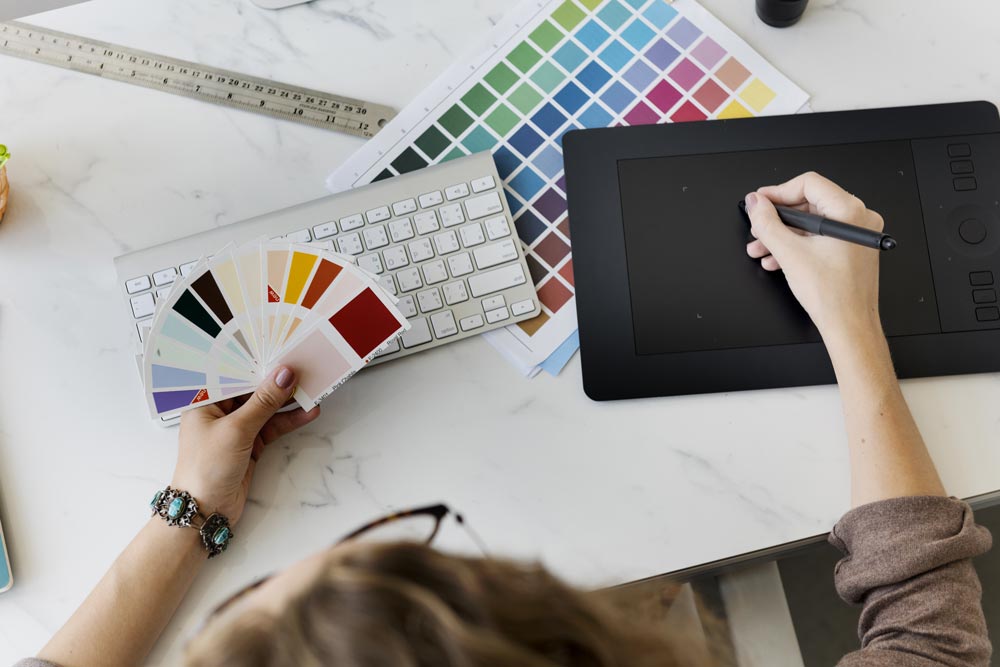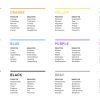
Did you know that science has actually found a connection between color and psychology? Color and psychology are interlinked because colors have an effect on the way people perceive the images that they view. Brands need to pay attention to the types of colors that they use in their color scheme to make sure that those colors line up with the type of reactions they want from consumers.
When you choose a color palette for your logo design (and for your brand), you are influencing subconscious feelings that might be triggered in your future customers. It’s important to use those subconscious feelings to your advantage by invoking qualities that your brand embodies. Take the colors that match your brand’s attributes and use those in your visual choices.
Table of Contents
- Impact of Color in Marketing
- Interactive Effects of Colors and Products on Perceptions
- Choosing a Color Palette For Your Brand
- Color Blue
- Color Green
- Color Yellow
- Color Red
- Color Orange
- Color Purple
- Color Pink
- Color Black
- Color White
- Color Brown
- Difficulty Deciding Between Color Options
Impact of Color in Marketing
In 2006, researchers at the University of Winnipeg found that as many as 90% of all quick judgments are made about products solely on their color. That’s an incredible statistic. While there were some caveats (and it depended on the product), the data showed that the color of the product was vital in determining how consumers felt.
When customers have to make a snap judgment about a product, they place an even higher value on the color associated with it. Applying this study to logo design, we see that the color scheme chosen for a brand is critical to ensuring customers connect with the brand.
Interactive Effects of Colors and Products on Perceptions
Also in 2006, Cardiff Business School published a study that showed that not only were color choices important to the way brands were perceived, but also that the perceived “fit” was important. What does that mean? It means that customers judged brands on whether they thought the color choice fit their industry, fit their products, and fit their services.
Placing your brand properly within your industry is directly tied to achieving a sense of color harmony (between your niche & audience). It’s also important to look at products. For example, a fisherman who wants to buy a high-quality fishing rod (that would work well for sports fishing), is unlikely to buy a special silver edition fishing rod that sparkles. The color choice — silver sparkles — doesn’t line up with rugged, outdoorsmen. Understanding what role your product or service serves is vital to understanding what colors to choose to represent your brand.
Choosing a Color Palette for Your Brand
When choosing a color palette for your brand, it’s important to remember that a color palette extends beyond logo design. Logo designs are one aspect of branding, but you will want to create various visual elements such as iconography and other graphics as you market your brand. Choosing a color palette that includes your logo design colors (but also sets color standards for your social media ads and website design), is the best way to create consistent branding for your business.
Color Blue
Blue is the most popular choice for businesses when it comes to branding. Why? It is universally beloved and has a host of wonderful qualities including peace and tranquility. Other qualities associated with the color blue are tranquility, focus, power, professionalism, and trustworthiness.
The color blue is a universal color that works well for any type of business. It makes the most sense for businesses that need to promote feelings of safety and professionalism such as medical, scientific, or health care fields. It also works well for agencies that need to present power and show that they are serious such as governments and governmental agencies. Corporations and tech companies also love the color blue.
Color Green
The second most popular color choice from a branding perspective is the color green. Green has qualities that reflect eco-friendly, youth-based, and natural elements. It highlights adventure, energy, the environment, the ecosystem, and education.
Green is a popular color choice for brands that are food-based or brands that want to demonstrate a connection to the environment. Green is also great for corporations that want to express energy without going for a loud color such as red. Green is also a fantastic choice for higher learning institutions.
Color Yellow
The color yellow is a bright color and can appear in a wide variety (from gold to canary yellow). In general, yellow is a great color for brands that need to reflect high energy. Yellow has qualities that are energetic, driven, youthful, inventive, innovative, positive, sunny, encouraging, bright, and happy. However, the color yellow can also be used to symbolize danger or warnings (think yellow stop light). The key to the difference lies within the tone of yellow used, as well as the other colors used in combination.
Yellow is a great choice for businesses that are in the entertainment industry or that deal with food. Anything that needs to convey bright, high energy. Businesses that revolve around children, cutting-edge technology, and automotive needs are also great.
Color Red
The color red is a wonderful color at drawing attention, but its qualities do not fit every brand. Red is exciting and can convey romantic sentiment. It can symbolize power, urgency, and danger. It is the color most likely to generate feelings similar to an adrenaline rush.
When using the color red in branding, we recommend thinking about whether or not your brand needs to be exciting or promote a sense of urgency. Red is best for businesses in retail, fashion, cosmetics, and food. Red also does well with sports, real estate, and entertainment industries. Urgency comes into play for health care and emergency services. Red has also been a popular color for anything dealing with the public in a fast-paced way such as advertising or public relations.
Color Orange
The color orange (similar to some of the previous colors) elicits a sense of energy, but is typically geared towards intense enthusiasm and child-like qualities. It’s also great for brands who need to connect with a youthful feeling. Orange is the most playful color for brands. The color orange can also feel creative and pique interest, which makes it a fun color to use to highlight certain designs.
The playfulness lends itself to companies that work with children or work in education. We also see a lot of orange in entertainment and companies that focus on human resources.
Color Purple
Purple holds qualities that are mysterious and spiritual. The color purple is often associated with spirituality, religious practices, sensuality, the mind/body connection, as well as general well-being. Purple can also add a magical or fantasy element.
The color purple is best for businesses that specialize in self-care, spirituality, the body, and the mind. Businesses such as psychology offices, astrology offices, massages, gyms, fitness, and spiritual organizations would benefit from choosing the color purple. When purple evokes magic and fantasy, it can be a great choice for children or a one-of-a-kind travel business.
Color Pink
Pink traditionally has been associated with women, but this really depends on the type of pink used. Pink has qualities that include purity, delicacy, care, and friendliness. Bright and bold pinks have a vibrancy and youthful energy associated with them. They can even raise heart rates and are great for engaging customers.
The color pink is often associated with women and so you will see it as a primary color for a variety of women’s brands. However, pink is also used to represent hope and to provide a calming quality. This makes it a great choice for dessert shops (think Baskin Robbins) or to add life and vitality with a darker shade of pink (think T-Mobile). Pink has often been used in wedding planning, bakeries, and the fashion industry but can easily — in the right shade — be used in any industry.
Color Black
Black projects a sense of strength, precision, credibility, and focus. It is professional but also adds a level of force and blunt straightforwardness. Black is another serious color but it can come across as more aggressive when compared to white.
The color black is best used for companies in the beauty, corporate, financial, marketing, and fashion industries. Black can be used across the board, but one of the pitfalls is it can potentially add a heaviness to a brand that should otherwise come across as upbeat or cheerful. Black needs to be carefully balanced with other colors depending on the industry.
Color White
White is an important color in color schemes because many people forget that white is actually a color. If you are going to use white, don’t simply list the color as negative space. White needs to be identified and if it is a large part of your logo design, it needs to be known and listed in your brand’s style guide. The color white projects ease, innocence, purity, cleanliness, and simplicity.
White is best used for industries where cleanliness and clinical needs are vitally important. It works well in dental, medical, scientific, high-tech, and innovative brands. That said, white can be used in virtually any color scheme. The danger when using white is that white can potentially depict a clinical/sterile environment which may make a brand seem cold (this depends on the brand’s industry).
Color Brown
The color brown is more sparingly used when it comes to branding. Brown tends to work best when paired with other colors in a more equal and even usage pattern. The color brown has qualities that are safe, reliable, and steady. The color also conjures up feelings of being grounded and connected to the earth.
Brown is best used for businesses that deal with the ground and need to project safety as well as reliability. Construction and mining industries both often use brown as part of their color scheme. Brown has also been used frequently in ecological, real estate, scientific, and finance businesses.
Difficulty Deciding Between Color Options
If you are having a difficult time deciding between color choices, we’d be happy to talk. Professional logo designers and branding designers spend a lot of time working with clients across a myriad of industries. We know what works best for individual companies and part of our job is understanding how to use color in a way that works for your brand. If you need help deciding which avenue to take with your color palette, let us know. We’d be happy to help you make the best choice depending on your brand’s identity.
Are you still zeroing in on your ideal color palette? Do you have additional questions about what types of color schemes might make the most sense for your brand? Interested in developing a logo design color palette with additional color ranges for iconography and marketing graphics beyond your logo design? Here at Logo Coast, we welcome all questions and would love to help you define and refine your color options for your brand.












